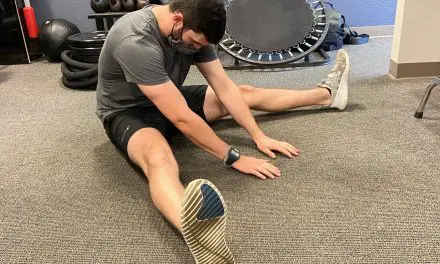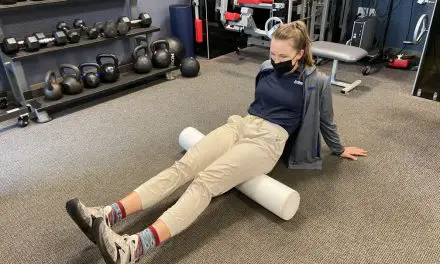Resistance bands come in many colors, materials, thicknesses, and shapes. Bands can be made of elastic fabric, flat latex, latex tubing with a handle, or the long, thick loops used to assist with difficult exercises in CrossFit.
While bands can be useful for building strength, they are also portable and take up very little space. They also allow you to target muscle groups through cueing. For example, if your knees cave in while squatting, a band just above your knees can cue you to push your knees out.
Whatever your reason is, one thing is for sure—there is band work to suit every muscle group and every strength goal.
Can you really build big muscles with resistance bands?
Building muscle mass is more about creating appropriate loads than what type of resistance you use. If your bands are strong enough, you can and will create muscle hypertrophy, which is a fancy way to say “muscle growth.”
Hypertrophy and strength are not the same thing, but it’s nearly impossible to complete a program with a hypertrophy focus without also getting stronger as a by-product. That said, if your goal is to get stronger, a program that is focused on growth will not allow for the type of overload that is necessary to get to loads of 85% of one-rep max or more.
To put on mass, you have to create small tears in the muscle that trigger a response from your body to repair the damage. The process of repair involves sending nutrients (including protein) to the area. When this process is repeated over time, the result is larger, stronger muscles and thus, more muscle mass.
To create these small tears, you have to safely but effectively load the muscle. Muscles work according to the SAID principle—or specific adaptation to imposed demands. If you want your muscles to get bigger and stronger, you have to progressively load them so the adaptation can occur. Depending on your age, body composition, and training level, an appropriate load could be a green therapy band that provides eight pounds of resistance or it could be a band that provides 50 pounds of resistance.
Can you build strength with resistance bands?
Muscle hypertrophy and muscle strength are not the same thing. Muscle hypertrophy simply means the muscle has gotten larger whereas strength is a measure of muscle function. Muscles that get bigger may also get stronger but muscles that get stronger do not necessarily get bigger. Factors, such as neuromuscular coordination, fiber type, and intensity of training, influence strength development far more than hypertrophy.
While they’re not the same thing, a single training program can influence both hypertrophy and strength.
A recent study compared different training approaches in healthy, trained men. These guys were assigned to a rest-pause, drop-set, or traditional training group for an 8-week program. The study found that both training types were as effective as traditional training for creating muscle hypertrophy and increasing strength.
A 2019 systemic review and meta-analysis compared the effects of elastic resistance training with conventional resistance training. The researchers found that both types of training were effective for increasing strength. Resistance band training is a viable option for building strength with access to traditional gym equipment is limited (or just not wanted!).
As with hypertrophy, the SAID principle plays a large role in building muscle strength. If you want a muscle to get stronger, you have to train it with progressively heavier loads over time. Those loads can be provided by bands, free-weights, machines, or anything else you can think of that creates a load.
How to build muscles with resistance bands
To build muscles with resistance bands, the general principles of strength training apply.
- Sets and reps: Choosing your sets and reps depends on your fitness goals. For pure strength goals, you should perform 2 to 6 sets of 1 to 5 reps using heavy resistance. You will know the resistance is heavy enough when the last two or three reps are difficult.
- Volume: Volume depends on your training level. If you are new to resistance training, starting with two or three sets of one to three reps will likely lead to better training sessions than jumping straight to six sets of five. A more trained lifter can safely use a six sets of five reps scheme to build strength with elastic bands.
- Concentric and eccentric contraction: Concentric (shortening) and eccentric (lengthening) contractions are part of all movements and are different types of muscle contractions. For reasons physiologists have yet to explain, we are stronger during the eccentric portion of the muscle contraction. If you are looking to build strength, you can take advantage of this phenomenon by focusing on the eccentric contraction during your sets.
To know you are properly loading the eccentric portion of an exercise, you should need help during the concentric portion. For example, to perform an eccentric bicep curl with a resistance band, the band should be heavy enough that your single arm can’t perform the concentric portion of the rep without the assistance of your other arm.
Once you reach the top of the concentric portion of the exercise, your single arm slowly controls the lowering motion as your arm returns to your side. It may be helpful to think about it as if you’re slowing the band down during the exercise. - Rest periods: Rest is determined by the other factors in the program. If you are truly programming for strength, you may need 3 to 5 minutes of rest between heavily loaded sets. For more moderate programming (think: 3 to 5 sets of 6 to 10 reps) one or two minutes of rest should be enough to safely move through your session.
How to use periodization to maximize your results
Describe how periodization can help someone improve their workout progress. Give an example of a beginner’s workout plan for a month.
Periodization is a training principle that organizes a workout program to achieve your fitness goals. Strength training typically has three phases or periods. The phases are:
- Hypertrophy: Focus is building mass using moderate to high loads and reps. The goal of hypertrophy is to gain mass and prepare your body for the heavier sessions that come in the strength phase.
- Strength: Focus is building strength. This phase uses heavier weights and lower reps to progressively overload the muscle according to the SAID principle.
- Power: Focus is on strength and speed which is often referred to as explosive movement. Exercises typically use lighter weights and more reps than the strength phase with a focus on generating force quickly.
Periodization allows you to vary the components of your program over time in an organized way. Using the specific phases or periods can help avoid plateaus and ensure progress continues to be made. Periodization also helps decrease overtraining or training injuries by varying the intensity and volume of a program over time.
A sample program 12-week for a beginner lifter might look like this:
Phase 1: Hypertrophy (weeks 1-4)
- Frequency: 2-3 days/week
- Warm-up: 5-10 mins
- 3-5 exercises
- 3-4 sets
- 10-15 moderate reps
Phase 2: Strength (weeks 5-8)
- Frequency 2-3 days/wk
- Warm-up: 5-10 mins
- 3-5 exercises
- 2-4 sets
- 4-6 heavy reps
Phase 3: Power (weeks 9-12)
- Frequency: 2-3 days/week
- Warm-up: 5-10 mins
- 3-4 exercises focused on quick movement (may include plyometrics or jump training but does not have to)
- 3 sets
- 10 moderate reps
Risks of using resistance bands
The major drawback of resistance band training vs. traditional machines or free-weights is that they may not provide enough resistance if you’re already quite strong. Also, there’s a large gap between the resistance provided by the heaviest flat band (4 to 18 pounds for a black band) and the resistance provided by the larger, thicker bands (minimum 30 pounds).
Another drawback of resistance bands is that they can be awkward to use in full-body exercises. For example, the band placement needed to create resistance during a squat is either quite difficult for your hands and shoulders. To squat with the band in a “bar” position, it wraps under your feet and is held in your hands while you complete the exercise.
Alternatively, the band can loop around your neck while you squat up and down but that can create a lot of uncomfortable pressure to your neck joints and muscles.
During a heavy deadlift, the band would need to be under both feet and then held in your hands. Holding the band in your hands is likely to be limited by grip and upper body strength.
Finally, these bands wear out and create a safety hazard. A well-used band will show signs of wear and tear but when the last safe repetition is going to be is impossible to know. A simple Google search of “resistance band fails” will show you more than enough to proceed with caution.
What types of resistance bands can I use?
There are several common types of resistance bands that you can use.
- Pull-up assisted: These bands typically come in large loops with resistance greater than 50 pounds. They can be securely looped around the bar so that you can step into the loop and get assistance with your pull-up.
- Functional training cable: These are like a one-stop-shop for resistance band training. A single band comes with anchor straps, foam handles, loops handles and a sliding foam sleeve for comfort.
- Anchor Point bands: This brand makes several resistance training products but their most convenient and easiest to use are the large and small loops that are meant to be used with your body as the anchor.
For example, if you’re working on your glutes, the band goes around your thighs so that one leg is moving into the resistance while the other leg is stabilizing the band. - Resistance band bar: This product can be an “add-on” to some resistance band systems. The bar is made to be attached to the band on either side so that pulling or pushing the bar is resisted by the bands.
- Tube: Resistance tubing is often used in pre-fabricated products that have handles or ankle cuffs. The resistance provided by the tube is the same as that provided by a flat band or the thicker version that is used for body weight support.
- Loop: The term “loop” is used to describe several products that are meant to provide external resistance by encircling your body parts. Loops can be made of elastic fabric, flat latex, tubular latex, or rubber.
- Figure 8: The tools are usually made with tubing and are designed such that there is a handle on each side of a loop with a connection in the middle that divides the loop into two circles.
- Therabands: Theraband is a brand that makes flat bands, tubular bands, loops, tubing with handles, consecutive loops, heavy bands and FlexBars—all of which are quite popular in the rehab world.
Precautions on using resistance bands
When buying resistance bands there are a few things you should look for:
- Resistance level: Not all elastic bands are created equal. Ten pounds of resistance can feel quite different from brand to brand. The best bet is to try before you buy. The second best bet is a good return policy so that you don’t get stuck with something you can not use.
- Material: Resistance bands can be rubber, latex, fabric or some other material. If you have an allergy to latex but do not like the fabric or rubber options, look for latex-free options.
- Length and size: The right size band can make all the difference in the world during your workout. Having to constantly adjust your hand placement to get equal resistance on each side can be maddening.
- Handles or loops: Do not underestimate the value of a well-placed handle. Handles or loops can help cut down on the chances you wind up with blisters or an exercise tool that acts like a tourniquet while you use it.
- Age: These bands are plentiful at discount stores (think Five Below, TJ Maxx, Ross, etc.). You will want to make sure you check the integrity of the band if you are buying from these places- look for dry, cracked areas of the band. Double check that handles or loops are secure when tensioned. Stretch the band to be sure there are no holes before you take it home with you.
- Brand: There are a ton of brands on Amazon that all sell the same product with a different logo. In general, price is not a good indicator of quality when it comes to this type of product because the price is often set based on how much supporting material you get. For example, bands that come with posters or links to potential exercises are more expensive.
Summary
Resistance bands can be useful in any workout program. They’re ideal for small spaces or to take on the road when you will be traveling. Whether part of a program that also incorporates free weights and machines or a band-only program, these tools can help you build larger, stronger muscles!

Penny Goldberg, DPT, ATC
Penny Goldberg, DPT, ATC earned her doctorate in Physical Therapy from the University of Saint Augustine and completed a credentialed sports residency at the University of Florida. She is a Board Certified Clinical Specialist in Sports Physical Therapy.
Penny holds a B.S. in Kinesiology and a M.A. in Physical Education from San Diego State University. She has served as an Athletic Trainer at USD, CSUN, and Butler University.
She has presented on Kinesiophobia and differential diagnosis in complicated cases. Penny has published on returning to sports after ACL reconstruction and fear of movement and re-injury.
Outside of the clinic, Penny enjoys traveling, good cooking with great wine, concerts, working out and playing with her dogs.





